What do candidates on the PAT Testing course actually do?
We give our candidates a brief overview of the legal requirements so that they understand why they need to do pat testing and the competence issues surrounding pat testing. We then look at how the testing should be carried out.
PAT INSPECTION We focus on the importance of the visual inspection of portable appliances, and provide candidates with the opportunity to discuss various incorrectly-wired plug-tops, cable and appliance faults, using a series of pictures of the offending appliances to guide them. The following are some example pictures from our photographic library of dangerous appliances, showing a damaged plugtop, a mains cable with a bad connection and an appliance that is wired incorrectly. We train our candidates to be able to spot these sorts of dangers, emphasising the importance of the visual inspection part of the pat testing procedure:
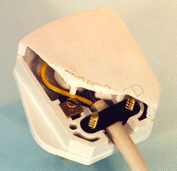 |
 |
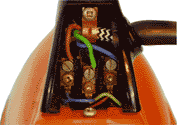 |
One of the pictures of a faulty plug-top used on the PAT testing course |
One of the pictures of a faulty cable used on the PAT testing course |
One of the pictures of a faulty appliance used on the PAT testing course |
The electrical PAT tests are then explained, with a comprehensive set of course notes which help to clarify which tests should be done and what the acceptable pass/fail limits of each test are. Useful reference tables dispense with the need for the candidates to perform complex calculations, for example in the case of the maximum earth continuity test readings allowed when portable appliances have longer leads. The following are some example pages from the course notes for this stage of the PAT testing course, depicting the important distinction that needs to be made between Class I and Class II appliances, the maximum allowable appliance earth bond resistance and the subtle differences between the various types of IEC lead that are often found connected to portable appliances:
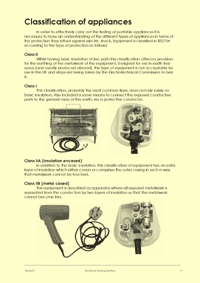 |
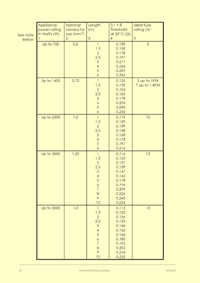 |
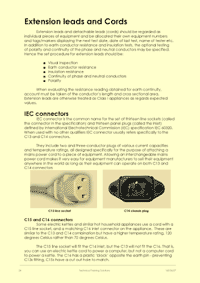 |
Page 9 of the course notes provided on the PAT testing course, describing how portable appliances are classified as Class I or Class II types |
Page 18 of the course notes provided on the PAT testing course, listing the maximum earth bond resistances that portable appliances can exhibit |
Page 24 of the course notes provided on the PAT testing course, describing the subtle differences between the various types of IEC lead that are often found connected to portable appliances |
| Inevitably there will be appliances that the candidates encounter in the future of their PAT testing experience where it would be wise to replace the plug. The first practical exercise on our course is therefore showing them how a mains plug should be wired and each of the candidates need to show us that they can do this. |  |
PAT TESTING Candidates then perform the inspection and testing on a range of typical portable electrical appliances, including kettles, irons, electric drills, extension leads, IEC leads, multiblocks etc. This part of the course is very practical and the candidates get the opportunity to discuss the various issues surrounding inspection and testing of portable appliances as they progress through the exercises. Because we need to be confident that the candidates are able to perform the inspection and testing properly, our instructors check that each and every candidate understands this essential part of PAT testing.
There are a total of 26 different appliances - some of them fail the visual inspection, some fail the electrical tests and some are passed as safe to use. We do of course make it clear that although we are using small domestic appliances here that the same inspection and testing regime would apply to powerful spotlamps used in the TV industry, concrete mixers used on construction sites, etc.
However, all the appliances we are testing here are terminated in a plug. We make it clear that any appliance that is wired in permanently (without a plug/socket) is beyond the scope of this course and is the subject of the Fixed Equipment Testing Course No 170.
 |
 |
Exercise 2: Some of the appliances tested on the PAT testing course |
Exercise 3: Some of the appliances tested on the PAT testing course |
 |
 |
Exercise 4: Some of the appliances tested on the PAT testing course |
Exercise 5: Some of the appliances tested on the PAT testing course |
The candidates use 4 different industry standard PAT testers. We have selected a good range of them so that they can see the similarities and differences between them.
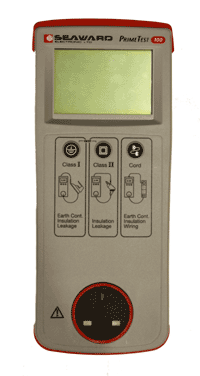 |
 |
The Seaward PAT tester used on the course |
The Kewtech PAT tester used on the course |
 |
 |
The Martindale PAT tester used on the course |
The Megger PAT tester used on the course |
As well as gaining valuable experience and acquiring the skills needed to perform the PAT tests, the exposure to a wide variety of PAT testers allows candidates who are undecided about which PAT tester they should be using or how they intend to organise the PAT testing procedures to gain important insights into how this could be carried out in their organisations.
We also demonstrate to the candidates that PASS/FAIL types of PAT testers can be used, getting them to see their advantages and disadvantages. Candidates are reminded of the importance of calibration of PAT testers and they can use our calibration checkbox to check that our PAT testers are within calibration. We also like to demonstrate to the candidates that an ordinary insulation / continuity tester could in fact be used to perform the PAT tests. The following are the PASS/FAIL type PAT tester, the PAT calibration checkbox and an insulation / continuity tester that could be used to perform the PAT tests:
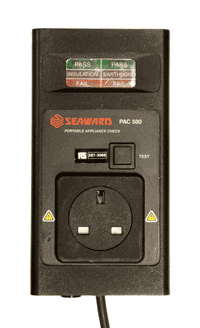 |
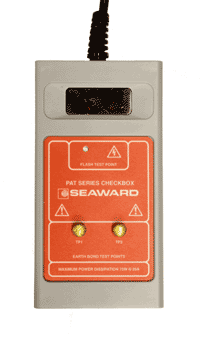 |
 |
The PASS/FAIL type of PAT tester used on the PAT testing course |
The calibration checkbox used on the PAT testing course |
Our instructor demonstrates how an insulation and continuity tester can be used for PAT testing |
PAT RECORD KEEPING We then explain the record-keeping requirements and show the candidates examples of the certificates commonly used for recording the results of PAT testing. Candidates can then complete some example forms for themselves with the results that they have gained from the inspections and tests that they have carried out previously.
If you would like to see some of the equipment used on the PAT testing training course for yourself, then please call us to arrange a visit to our offices in Kent. Alternatively, we can visit you anywhere in the British Isles.


